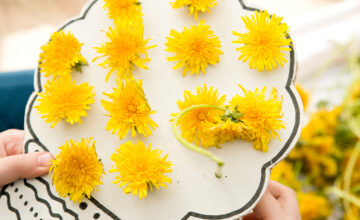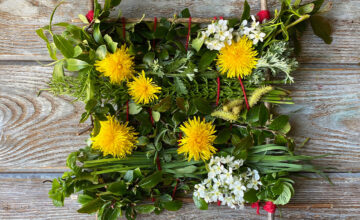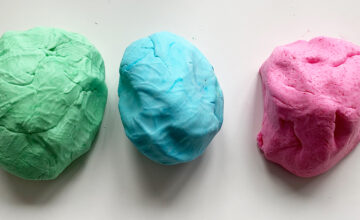
Rainbows have a special way of bringing smiles and a sense of wonder to both kids and adults alike. Capturing the vibrant essence of a rainbow in a sensory bin not only adds a splash of color to playtime but also creates a rich, tactile experience for little hands. This rainbow sensory bin project is the perfect way to combine creativity, learning, and sensory exploration into one delightful activity. It’s designed to be simple enough for children to help with the setup, making it a fun and engaging craft that leads to hours of imaginative play.
The beauty of this sensory bin lies in its versatility and the endless possibilities for sensory play. By using materials like colored rice and a homemade cardboard rainbow, this activity brings the excitement of discovering a rainbow indoors, allowing kids to explore colors, textures, and fine motor skills in a playful environment. Let’s dive into how you can create this colorful world that promises to be as educational as it is entertaining.

Materials Needed
- Colored rice
- Cardboard
- Scissors
- Glue gun
- Colored bowls (in the colors of the rainbow)
- Scoopers, spoons
Step by Step Instructions
Creating the Cardboard Rainbow Sensory Board
- Prepare the Base: Start with a large piece of cardboard. Using a compass or a string tied to a pencil, draw a semi-circle that’s large enough to serve as the base for your rainbow. Carefully cut out the semi-circle using scissors.
- Cut the Strips: Measure and cut out 3-inch-wide cardboard strips. These strips need to be of varying lengths to fit the curvature of your semi-circle, with each one slightly shorter than the last to mimic the natural arch of a rainbow. You will need six strips in total to represent the traditional colors of the rainbow.
- Form the Arches: Begin with the longest strip, which will represent the outermost arc of the rainbow (usually red). Apply hot glue along the top edge of your semi-circle base and carefully place the strip, curving it to follow the edge. Press firmly until the glue sets.
- Add More Arches: Proceed to glue the remaining strips below the first one, each representing the next color in the rainbow sequence. Ensure there is a small gap between each strip to create distinct arcs. These gaps will later be filled with the colored rice.
- Secure the Structure: Once all the strips are in place, go over any loose ends or unstable parts with additional glue to ensure the rainbow is sturdy and ready for play.

Making Colored Rice
- Prepare the Rice: For each color of the rainbow, measure about 1 cup of white rice and pour it into a ziplock bag.
- Color the Rice: In a small bowl, mix 1 tablespoon of vinegar with 10 drops of food coloring. The more food coloring you use, the more vibrant your rice will be. Pour this mixture into the bag with the rice.
- Shake to Coat: Seal the bag tightly and shake it vigorously until all the rice is evenly coated with the color mixture. Repeat this step for each color you plan to use in your sensory bin.
- Dry the Rice: Spread the colored rice out on a baking sheet lined with parchment paper. Allow it to dry completely, which can take several hours. To speed up the process, you can place the baking sheet in an oven set to the lowest possible temperature for 5 minutes, checking frequently to ensure the rice doesn’t cook.

Setting Up the Rainbow Sensory Bin
- Prepare the Play Area: Place the completed cardboard rainbow in a shallow bin or on a large tray. This will help contain the rice and make cleanup easier.
- Accessories: Introduce various scoopers, spoons, and colored bowls into the bin. Match the bowls to the colors of the rainbow rice to encourage color matching and sorting activities.
- Fill the Arches: Once the rice is dry, place each color in a similarly coloured bowl.
- Invite Exploration: Then invite your little one to fill each arc of your cardboard rainbow with the corresponding colored rice. Encourage your child to explore the bin. They can scoop and sort rice, create patterns, or simply enjoy the sensory experience of running their hands through the brightly colored grains.


By following these detailed instructions, you’ll create a captivating and educational rainbow sensory bin that offers endless opportunities for creative play and learning.
How They Played
My kids were immediately drawn to the bright colors and couldn’t wait to dive in. They spent hours scooping rice from the bin into the colored bowls, carefully sorting each color to match the rainbow. They also enjoyed burying small toys under the rice and finding them again, turning it into a treasure hunt. The cardboard rainbow became a focal point for their imaginative play, serving as everything from a magical barrier to protect treasures to a sorting station for their collected items.
Tips for Success
- Make sure the rice is completely dry before use to avoid color transfer.
- Supervise younger children to ensure rice isn’t ingested or placed in ears/nose.
- Consider placing a sheet or tablecloth under the play area for easy cleanup.
- Encourage kids to mix colors to discover new shades and practice color recognition.
Skills Learned
Fine Motor Skills: Scooping, pouring, and picking up grains of rice strengthen hand-eye coordination and dexterity.
Color Recognition: Sorting rice into the corresponding colors of the rainbow arcs reinforces color identification and matching skills.
Sensory Processing: The tactile experience of handling the rice stimulates sensory processing, important for cognitive development.
Creativity and Imagination: Interacting with the sensory bin sparks imagination, allowing children to create their own stories and scenarios.
Sorting and Organizing: Placing rice into the colored bowls practices sorting and organizing, foundational skills for mathematics and logical thinking.
This rainbow sensory bin is more than just a play activity; it’s a multi-sensory experience that educates as it entertains. Through the simple act of play, children can explore the wonders of colors, enhance fine motor skills, and let their imaginations soar.
Play2Learn Toddler & Preschool Programs for Curious Toddlers
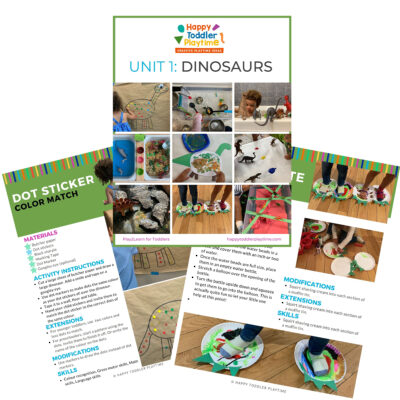
There is no limit to your toddler’s energy and curiosity. That energy and curiosity although a joy can be challenging at times. Their interest in just about everything around them is what makes them great learners. One and two year olds can soak up so much just from their senses!
But as a teacher or parent that thirst for learning can be exhausting. That is why I created this toddler and preschooler program. To help you get the most out of this time with your curious toddler without having to come up with creative ways to play and interact with them.
Play2Learn for Toddlers includes 20 Units for toddlers. Each 2-week toddler unit has 20 super easy to set up and engaging activities for toddlers 18 months to 3 years.
Play2Learn Preschool which includes 20 Units for preschoolers. Each 2-week preschoolers unit has 20 unique and easy to set up and engaging activities for preschoolers 3 years to 5 years. That’s over 800 learning activities for your toddler and preschooler at your fingertips! So many ideas you and your child will never be bored again!
These toddler and preschool lesson plans and activities will definitely keep you and your toddler and preschooler busy playing and learning!
Click here for more information: Play2Learn
Book: Exciting Sensory Bins for Curious Kids

Did you know I wrote a book of sensory bins? Click here for more information Exciting Sensory Bin for Curious Kids. Or grab your copy at Amazon.
Boring afternoons are made exciting with awesome animal-based bins, like Salty Shark Bay or Yarn Farm. Pretend play bins like Birthday Cake Sensory Play or Bubble Tea Party encourage creativity and imagination. And your kids will have so much fun they won’t even know they’re getting smarter with STEAM (science, technology, engineering, art and math) activities like Sink or Float Soup, Magnetic Letter Hunt or Ice Cream Scoop and Count.
Designed for toddlers 18 months and up.
Book: Super STEAM Activity Book for Kids
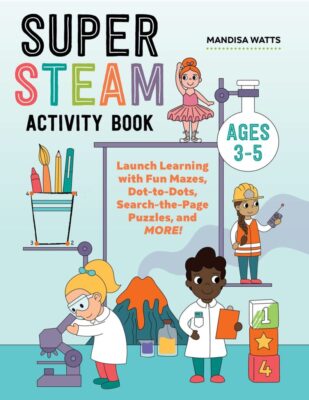
Learning all about science, technology, engineering, art, and math sets kids up for scholastic success―and it can be so much fun! Watch kids enjoy building STEAM skills as they color friendly fish, help water find its way to tree roots, solve math problems with mazes, and more.
Find out more and grab your copy here.
Designed for preschoolers 3 years old and up.
Book: Big Book of Riddles for Kids
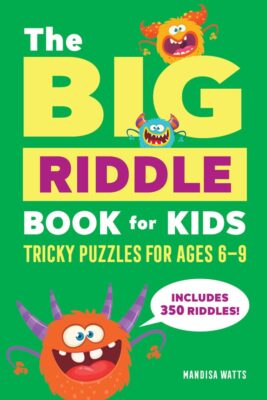
Riddle me this: What’s an exciting way to practice critical thinking while having a blast? The Big Riddle Book for Kids, of course! From hilarious puns to tough brain teasers, kids can build problem-solving skills with hundreds of riddles tha. t show them how to think outside the box.
- 350 riddles for kids—Have hours of fun with riddles, puns and jokes, and math and logic puzzles that’ll get their wheels turning!
- Level up their skills—Riddles get trickier as kids progress through the book, challenging them as they get better at solving puzzles!
- Double-check their work—Kids can check their answers in the back of the book with a handy answer key.
Help children expand their minds while having fun with this puzzle book for kids!
Designed for kids ages 6 years old and up.
TV Show: Curious Crafting
I’m so excited to share my crafting TV show Curious Crafting which launched in July 2022 on TVOkids and TVOkids YouTube! Season 2 aired in August 2023! My show was also nominated in 2023 for Best Live Action Preschool Series by the Youth Media Alliance Awards of Excellence.
Curious Crafting Season 1 is also now airing in Australia on ABC! Watch it here!
Set in the ultimate crafting space, Curious Crafting is a short form pre-school age series about the joy of making crafts. I lead a rotating cast of adorable little preschoolers (including my own) making magic out of common household objects.
In each episode we transform recycled items into magical crafts like a milk carton school bus, paper bag puppet or cotton pad turtle. The crafters learn and laugh their way through each activity while demonstrating what their young imaginations can create.
Curious Crafting shares the adventure and joy of making art with takeaway lessons for creating crafts at home.
This show designed for toddlers and preschoolers 2.5 years old and up.

Rainbow Sensory Bin
Materials
- Colored rice
- Cardboard
- Scissors
- Glue gun
- Colored bowls (in the colors of the rainbow)
- Scoopers, spoons
Instructions
Creating the Cardboard Rainbow Sensory Board
- Begin by cutting out a semi-circle from your cardboard. This will serve as the base for your rainbow.
- Cut out 3-inch-wide strips that are long enough to form an arch around the semi-circle. You’ll need enough strips to create 6 arches.
- Using the glue gun, glue the longest strip along the top edge of the semi-circle to start forming your rainbow.
- Continue gluing down each strip, one beneath the other, to create 5 more arches. These will form the compartments for the colored rice, representing the arcs of the rainbow.
Making Colored Rice
- To make colored rice, you’ll need white rice, food coloring, vinegar, and ziplock bags.
- For each color, mix 1 tablespoon of vinegar with several drops of food coloring in a ziplock bag.
- Add 1 cup of rice to the bag, seal it, and shake well until the rice is evenly colored.
- Spread the rice out on a parchment paper-lined baking sheet to dry.
Setting Up the Rainbow Sensory Bin
- Once the rice is dry, fill each arc of the cardboard rainbow with rice, matching the colors of the rainbow.
- Place the cardboard rainbow in a larger bin or on a tray to contain the rice.
- Add colored bowls and scoopers or spoons to the bin for sorting and scooping play.


